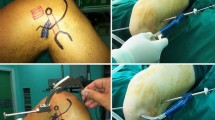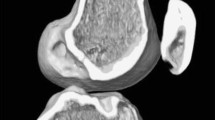Abstract
Background
ACL reconstruction is one of the commonest orthopaedic procedures performed. There has been a shift in techniques from single bundle to double bundle to anatomic single-bundle reconstruction and also from transtibial to anteromedial method. Anteromedial technique results in more anatomic femoral tunnel with graft positioned at the native insertion site. The tunnel position is crucial for better outcome after ACL reconstruction.
Purpose
To compare the femoral tunnel position made by anatomic single-bundle ACL reconstruction using femoral offset aimer device versus freehand drilling with 3D computed tomography.
Study design
A prospective case series involving 60 patients with ACL tear who underwent anteromedial single-bundle ACL reconstruction.
Methods
Computed tomography scans were performed on 60 knees that underwent single-bundle anteromedial ACL reconstruction with 30 cases involving femoral drilling through aimer device and another 30 cases involving freehand drilling of the tunnel. Three-dimensional models were created, and the data were analysed according to the co-ordinate axes method. Femoral tunnel position was measured in proximal-to-distal and posterior-to-anterior directions. Data from both the groups were compared with each other and already published reference data on anatomical tunnel position.
Results
In the aimer group, the femoral tunnel centre on the medial wall of lateral femoral condyle was located at 35 ± 9% in the posterior-to-anterior direction and at 30 ± 12% in the proximal-to-distal direction. In the freehand group, tunnel was placed at 37 ± 10% in posterior-to-anterior and 28 ± 7% in proximal-to-distal directions. There was no significant difference in tunnel position in both the groups.
Conclusion
This study shows there is no significant difference between both the drilling techniques of femoral tunnel, i.e. freehand drilling and drilling with aimer device. Also, it reiterates the efficacy and utility of computed tomography and three-dimensional reconstruction in the analysis of femoral tunnel in ACL reconstruction.






Similar content being viewed by others
References
Bedi A, Altchek DW (2009) The Footprint anterior cruciate ligament technique: an anatomic approach to anterior cruciate ligament reconstruction. Arthroscopy 25:1128–1138
Kopf S, Forsythe B, Wong AK, Tashman S, Anderst W, Irrgang JJ, Fu FH (2010) Nonanatomic tunnel position in traditional transtibial single-bundle anterior cruciate ligament reconstruction evaluated by three-dimensional computed tomography. J Bone Jt Surg Am 92(6):1427–1431
Biau DJ, Tournoux C, Katsahian S, Schranz P, Nizard R (2007) ACL reconstruction: a meta-analysis of functional scores. Clin Orthop Relat Res 458:180–187
Tashman S, Kolowich P, Collon D, Anderson K, Anderst W (2007) Dynamic function of the ACL-reconstructed knee during running. Clin Orthop Relat Res 454:66–73
Fithian DC, Paxton EW, Stone ML, Luetzow WF, Csintalan RP, Phelan D, Daniel DM (2005) Prospective trial of a treatment algorithm for the management of the anterior cruciate ligament-injured knee. Am J Sports Med 33:335–346
Nha K-W, Han J-H, Kwon J-H, Kang K-W, Park H-J, Song J-G (2015) Anatomical single-bundle anterior cruciate ligament reconstruction using a freehand transtibial technique. Knee Surg Relat Res 27:117–122
Celentano U, Cardoso MPA, Lamirez CP, Van Eck CF (2012) Use of transtibial aimer via accessory anteromedial portal to identify the center of the ACL footprint. Knee Surg Sports Traumatol Arthrosc 20(1):69–74
Forsythe B, Kopf S, Wong AK, Martins CAQ, Anderst W, Tashman S, Fu FH (2010) The location of femoral and tibial tunnels of anatomic double-bundle anterior cruciate ligament reconstruction analyzed by three-dimensional computed tomography models. J Bone Jt Surg Am 92:1418–1426
Meuffels DE, Potters JW, Koning AH, Brown CH, Jr VJA, Reijman M (2011) Visualization of postoperative anterior cruciate ligament reconstruction bone tunnels: reliability of standard radiographs, CT scans, and 3D virtual reality images. Acta Orthop 82(06):699–703
Lertwanich P, Martins CA, Asai S, Ingham SJ, Smolinski P, Fu FH (2011) Anterior cruciate ligament tunnel position measurement reliability on 3-dimensional reconstructed computed tomography. Arthroscopy 27(03):391–398
Markolf KL, Park S, Jackson SR, McAllister DR (2009) Anterior- posterior and rotatory stability of single and double bundle anterior cruciate ligament reconstructions. J Bone Jt Surg Am 91:107–118
Shin YS, Ro KH, Lee JH, Lee DH (2013) Location of the femoral tunnel aperture in single-bundle anterior cruciate ligament reconstruction: comparison of the transtibial, anteromedial portal, and outside-in techniques. Am J Sports Med 41(11):2533–2539
Funding
This study was not funded and received no grants.
Author information
Authors and Affiliations
Corresponding author
Ethics declarations
Conflict of interest
Both the authors declare that they have no conflict of interest.
Ethical approval
All procedures performed in studies involving human participants were in accordance with the ethical standards of the institution and with the 1964 Helsinki Declaration and its later amendments or comparable ethical standards.
Informed consent
Informed consent was obtained from all individual participants included in the study.
Additional information
Publisher's Note
Springer Nature remains neutral with regard to jurisdictional claims in published maps and institutional affiliations.
Rights and permissions
About this article
Cite this article
Dutt, S., Kumar, V. A comparative study of anatomical single-bundle anterior cruciate ligament reconstruction using femoral offset aimer versus freehand technique for femoral tunnel preparation. Eur J Orthop Surg Traumatol 30, 493–499 (2020). https://doi.org/10.1007/s00590-019-02595-0
Received:
Accepted:
Published:
Issue Date:
DOI: https://doi.org/10.1007/s00590-019-02595-0




